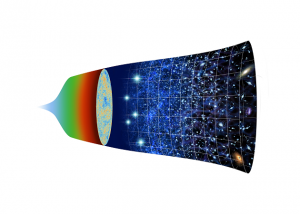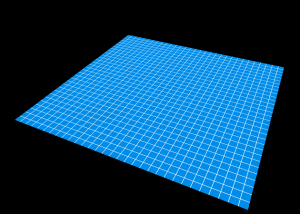In the Theoretical Astrophysics Group, we study two main subjects: dynamic phenomena involving black holes and neutron stars, and the origin and evolution of the Universe. Both are closely related to gravitational theory. In objects such as black holes and neutron stars, the relevant scales are quite different from those we are accustomed to on a daily basis. For example, the core of a neutron star is 1015 times more dense than water, rock or metal, whereas the Universe as a whole is 10-30 times less dense than these materials. Therefore, these objects are not as intuitively familiar to us as the Sun and planets. However, studying such extreme aspects of the Universe can lead to a deeper understanding of physics.
[Group Members] [Theoretical Astrophysics Group Web Site]
The Universe and Gravity
Gravitational interactions play a key role in the large-scale dynamics of astronomical objects, and determine stellar structure and motion. Under conditions of extreme gravity, a black hole can be formed. In the similar way, the evolution of the Universe is also determined by gravitation and the matter content. In Einstein’s General Theory of Relativity, gravity is described as a curvature of space-time. The flat space-time shown in the left panel below represents empty space. In the center panel, it is curved due to the mass of an object. In the case of two objects orbiting each other, time-varying gravitational waves are produced and propagate, as shown in the right panel.
Relativistic Stellar Objects
 The gravity associated with a dense collapsed object such as a black hole or neutron star is so strong that general relativity is required to describe it. Astronomical objects are mostly static and rarely exhibit time variations. The number of such compact objects is quite small compared with normal stars. However, they can be detected by sudden brightening, e.g., in the X-ray region. These relativistic stars often emit huge amounts of energy in a short time period, occasionally carried by neutrinos and/or gravitational waves. The image on the right illustrates how the inner structure of a neutron star could be probed by observing flares emitted from it. The variations inside a neutron star shake the exterior magnetosphere, and X-rays and gamma rays can be emitted. A theoretical approach is required in order to obtain meaningful information on strong-gravity environments and high-density states of matter, based on observations of these compact objects.
The gravity associated with a dense collapsed object such as a black hole or neutron star is so strong that general relativity is required to describe it. Astronomical objects are mostly static and rarely exhibit time variations. The number of such compact objects is quite small compared with normal stars. However, they can be detected by sudden brightening, e.g., in the X-ray region. These relativistic stars often emit huge amounts of energy in a short time period, occasionally carried by neutrinos and/or gravitational waves. The image on the right illustrates how the inner structure of a neutron star could be probed by observing flares emitted from it. The variations inside a neutron star shake the exterior magnetosphere, and X-rays and gamma rays can be emitted. A theoretical approach is required in order to obtain meaningful information on strong-gravity environments and high-density states of matter, based on observations of these compact objects.
Cosmology
 One of the aims of cosmology is to clarify how the Universe began and evolved. Studies of the cosmic microwave background and large-scale structure of galaxies have unveiled primordial density fluctuations and their evolution. It has been clarified that inflation and accelerated expansion of the early universe can successfully explain that the structure of the Universe is seed by these primordial density fluctuations, and that the current Universe is in the second phase of accelerated expansion. Precise observations and comparisons with theoretical predictions have made it possible to obtain more accurate information about the origin of dark energy relevant to the accelerated cosmic expansion and structure formation by dark matter.
One of the aims of cosmology is to clarify how the Universe began and evolved. Studies of the cosmic microwave background and large-scale structure of galaxies have unveiled primordial density fluctuations and their evolution. It has been clarified that inflation and accelerated expansion of the early universe can successfully explain that the structure of the Universe is seed by these primordial density fluctuations, and that the current Universe is in the second phase of accelerated expansion. Precise observations and comparisons with theoretical predictions have made it possible to obtain more accurate information about the origin of dark energy relevant to the accelerated cosmic expansion and structure formation by dark matter.
Extreme Universe and Astrophysics
Using theoretical approaches, we attempt to shed light on observed phenomena in the Universe, and explore the subjects in depth. For example, the primordial fluctuations in the Universe were generated during the inflationary era in accordance with the principle of quantum mechanics. The energy scale associated with cosmic inflation could be as high as 1016 GeV. Therefore, studying such primordial fluctuations through observational cosmology can lead to a verification of quantum mechanics at such extremely high energies. Astrophysical phenomena are often impossible to reproduce directly in a laboratory, and need to be approached using a combination of theoretical predictions based on physical principles, and astronomical observations.
Group Members

Nobuhiro Okabe (Associate Professor)
The invisible, unknown matter, so-called, “dark matter”, makes up about 85 percent of the mass of the Universe. Dark matter plays an important role to form galaxies and cosmic web network of large scale structure. Gravitational lensing effect, predicted by Einstein’s general relativity, enables reconstruction of dark matter distributions. I engage in research on dark matter distribution using the prime-focus camera of Subaru telescope. Visible master, so-called, “baryons” can be directly observed through optical, radio and X-ray wavelengths. I also engage in research to reveal the interplay between dark matter and baryons based on joint analysis of multiwavelength dataset.

Atsushi Nishizawa (Associate Professor)
Gravity is a force that is close to us but not yet fully understood. The modern theory of gravity is General Relativity, but the theory of quantum gravity remains incomplete. The properties of gravity in regions with strong gravitational forces, such as black holes, and at distance scales as large as the entire universe, have not been sufficiently verified. In 2015, the observation of gravitational waves generated by the merger of binary black holes allowed us to study regions with very strong gravitational fields, like those around black holes. Additionally, we can now “see” the invisible dark universe using gravitational waves. It is expected that in the future, we may even be able to observe the beginning of the Universe, such as the Big Bang and inflation. Using gravitational wave observations, I am studying the evolution of the Universe, testing gravitational theories, and searching for fundamental particles beyond the Standard Model.

Shota Kisaka (Assistant Professor)
The energetic outflows from compact objects such as black holes and neutron stars have been observed in which plasma is ejected to the surroundings at almost light speed. The examples are “relativistic jet”, and “pulsar wind”. I have been studying to answer the following questions: what is the mechanism that supplies a large amount of plasma, where and how plasma gets energy, and what is the mechanism of electromagnetic radiation and the physics that determines its efficiency? The targets are black holes, “Pulsars” where periodic pulses reflecting the rotation of neutron stars are observed, the merger products of neutron star binaries, and the recently discovered mysterious radio transients “Fast radio bursts”.
Illustration by AND You INC.



